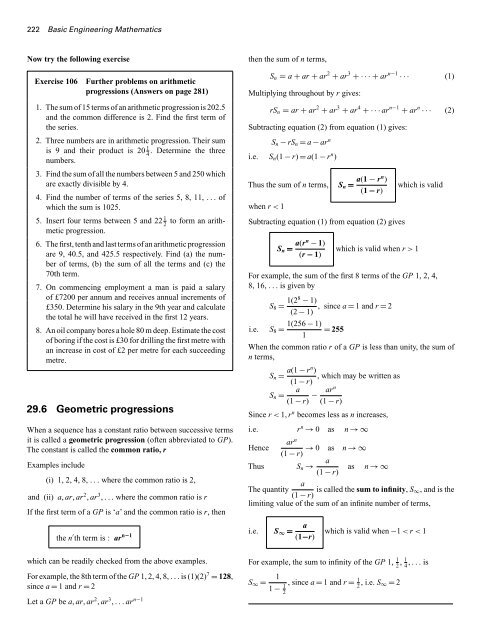basic_engineering_mathematics0
You also want an ePaper? Increase the reach of your titles
YUMPU automatically turns print PDFs into web optimized ePapers that Google loves.
222 Basic Engineering Mathematics<br />
Now try the following exercise<br />
Exercise 106<br />
Further problems on arithmetic<br />
progressions (Answers on page 281)<br />
1. The sum of 15 terms of an arithmetic progression is 202.5<br />
and the common difference is 2. Find the first term of<br />
the series.<br />
2. Three numbers are in arithmetic progression. Their sum<br />
is 9 and their product is 20 1 . Determine the three<br />
4<br />
numbers.<br />
3. Find the sum of all the numbers between 5 and 250 which<br />
are exactly divisible by 4.<br />
4. Find the number of terms of the series 5, 8, 11, ... of<br />
which the sum is 1025.<br />
5. Insert four terms between 5 and 22 1 to form an arithmetic<br />
progression.<br />
2<br />
6. The first, tenth and last terms of an arithmetic progression<br />
are 9, 40.5, and 425.5 respectively. Find (a) the number<br />
of terms, (b) the sum of all the terms and (c) the<br />
70th term.<br />
7. On commencing employment a man is paid a salary<br />
of £7200 per annum and receives annual increments of<br />
£350. Determine his salary in the 9th year and calculate<br />
the total he will have received in the first 12 years.<br />
8. An oil company bores a hole 80 m deep. Estimate the cost<br />
of boring if the cost is £30 for drilling the first metre with<br />
an increase in cost of £2 per metre for each succeeding<br />
metre.<br />
29.6 Geometric progressions<br />
When a sequence has a constant ratio between successive terms<br />
it is called a geometric progression (often abbreviated to GP).<br />
The constant is called the common ratio, r<br />
Examples include<br />
(i) 1, 2, 4, 8, ...where the common ratio is 2,<br />
and (ii) a, ar, ar 2 , ar 3 , ...where the common ratio is r<br />
If the first term of a GP is ‘a’ and the common ratio is r, then<br />
the n ′ th term is : ar n−1<br />
then the sum of n terms,<br />
S n = a + ar + ar 2 + ar 3 +···+ar n−1 ··· (1)<br />
Multiplying throughout by r gives:<br />
rS n = ar + ar 2 + ar 3 + ar 4 +···ar n−1 + ar n ··· (2)<br />
Subtracting equation (2) from equation (1) gives:<br />
S n − rS n = a − ar n<br />
i.e. S n (1 − r) = a(1 − r n )<br />
Thus the sum of n terms, S n = a(1 − rn )<br />
(1 − r)<br />
when r < 1<br />
Subtracting equation (1) from equation (2) gives<br />
S n = a(rn − 1)<br />
(r − 1)<br />
which is valid when r > 1<br />
which is valid<br />
For example, the sum of the first 8 terms of the GP 1, 2, 4,<br />
8, 16, ...is given by<br />
S 8 = 1(28 − 1)<br />
, since a = 1 and r = 2<br />
(2 − 1)<br />
1(256 − 1)<br />
i.e. S 8 = = 255<br />
1<br />
When the common ratio r of a GP is less than unity, the sum of<br />
n terms,<br />
S n = a(1 − rn )<br />
, which may be written as<br />
(1 − r)<br />
S n =<br />
a<br />
(1 − r) − arn<br />
(1 − r)<br />
Since r < 1, r n becomes less as n increases,<br />
i.e. r n → 0 as n →∞<br />
ar n<br />
Hence → 0 as n →∞<br />
(1 − r)<br />
Thus S n → a as n →∞<br />
(1 − r)<br />
a<br />
The quantity<br />
(1 − r) is called the sum to infinity, S ∞, and is the<br />
limiting value of the sum of an infinite number of terms,<br />
i.e. S ∞ = a<br />
(1−r)<br />
which is valid when −1 < r < 1<br />
which can be readily checked from the above examples.<br />
For example, the 8th term of the GP 1, 2, 4, 8, ...is (1)(2) 7 = 128,<br />
since a = 1 and r = 2<br />
Let a GP be a, ar, ar 2 , ar 3 , ...ar n−1<br />
For example, the sum to infinity of the GP 1, 1 2 , 1 4 , ...is<br />
S ∞ = 1<br />
1 − 1 , since a = 1 and r = 1 2 , i.e. S ∞ = 2<br />
2















![[Lonely Planet] Sri Lanka](https://img.yumpu.com/59845622/1/169x260/lonely-planet-sri-lanka.jpg?quality=85)

